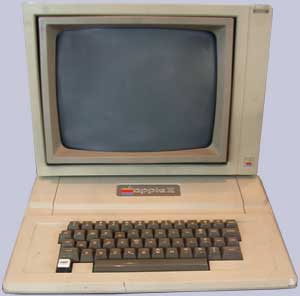Recollections of My Introduction to Computer Graphics
My first hands-on exposure to computer graphics came in 1982. I was working on my Masters Degree in Computer Science. I learned that the Art Department was offering a single master's level computer class on computer graphics. Unfortunately I no longer recall the exact course title. Fortunately I was able to convince my advisor to let me sign up for this class. The class was taught by Joan Truckenbroad and I was the only non-art student in the class.

In those days, things were much simpler in some respects but in other respects, much harder. With respect to simplicity for example, you didn't have to know anything about color theory because you only had two colors to work with: black and white. Actually our two colors were black and green as the computers were attached to green phosphor monitors. Unlike today. the size of our images were limited to the size of the screen. As I recall, our screen resolution was 280 pixels horizontally and 192 pixels vertically. Compare that with today's screen resolutions of 1,024 by 768 pixels or more. In terms of today's technology, our sophisticated works of art would amount to no more than a black and white thumbnail image in today's world.
As regards things being harder in those early days, that is due to the methods one had to use in order to create an image. As an artist, you did not directly create your image like people do today with applications that range from the primitive (Microsoft Paint) to the sophisticated (Adobe Photoshop or Corel Painter). Instead you had to write a program within the confines of the graphics package that you were using. To see your picture, you ran the program. If you didn't like the results, it was back to the keyboard for program modification. Having to write a program also diminished the ability to be spontaneous. I don't recall that we were able to save our graphics -- just the program itself.
Our hardware was the Apple II with, I think, 48K of RAM. The machine I am working on right now has 2Gig of RAM by comparison - almost 44,000 time more memory. For offline storage, we were restricted to a 5.25" floppy disk that could hold only 143 kilobytes. My PC today not only has multiple hard drives with a total storage capacity of almost a terabyte, but I am also able to write files to DVDs that each hold approximately 4.7 gigabytes. Today I routinely work with images that are on the order of 100 to 400 megabytes each - meaning that I would have to split my image between some 2800 floppies - an impossible task.
And of course there was no mouse or graphics tablet available - all input was done via the keyboard. And speed? The Apple II's we used were, for us, blazingly fast running at a whopping 1 megahertz. Today's PC CPUs typically run at a couple thousand megahertz.
My singular memory of this class was that I, a non-artist, was able to impress my fellow students in the class. Why? Because they were strangers to this new medium and had no programming background whereas I had been writing programs in different languages for three years. In this early confrontation of the romantic vs the geek, I am proud to say the geek won. This was most evident in our final project in which we each had to produce an animated graphic promoting ourselves. My fellow classmates came up with some very novel concepts and I could right off "see" how they did it. My graphic project impressed my classmates because they could not "see" how I did it. To them the multiple embedded loops and If-Else logic that I used in my program were a mystery.
One last respect in which things were simpler in those early days was with respect to choice. Back then there were very few graphic alternatives available to the buddng digital artist. Today there are platform choices, a variety of hardware choices, and a multitude of software choices that confront the novice -- any one of which is sufficient to induce a throbbing headache.
This was the product that inspired people in graphic design, and students, and other creative people. It was the whole idea of computers not just being something you would see in the office.
Ted Friedman on the Apple Macintosh